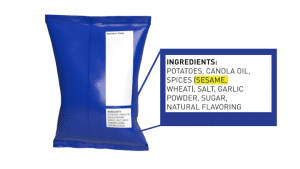Article by Sharon Gray MPH, RD
As of January 1, 2023, Sesame is now required to be labeled as an allergen on packaged foods, including dietary supplements. This has been the culmination of efforts for years among food allergy advocates. Sesame is now the country’s ninth major allergen, affecting approximately 1.6 million people (about the population of West Virginia) in the United States. Cases of Sesame allergy, some quite severe, have been rising in recent years along with a growing number of foods that contain the ingredient. Dr. Michael Pistiner, Director of Food Allergy, Education and Prevention at Mass General Hospital for Children believes one reason for the rise in sesame allergies is due to more people in the United States eating sesame- containing products (2019).
Sesame can be found in obvious places like sesame seeds on bagels. But it is also an ingredient in many foods from ice cream, hummus to protein bars and can be added to sauces, dips and salad dressings and hidden in spices and flavorings. Because it is in a lot of foods as hidden ingredients, it is very hard to avoid.
The Food Allergy, Safety, Treatment, Education and Reasearch (FASTER) Act became law in April 2021, requiring sesame to be listed on packaged foods beginning January 1, 2023.
This federal law establishing Sesame labeling by the Food and Drug Administration (FDA) does not require food products that were already on their way to the store or in stock before 2023 to list sesame as an allergen. So, unlabeled packaged foods will still be on store shelves in the near future. However, the new federal law did go into effect on January 1, adding sesame to the list of allergens that must appear on food labels if present in the product. Unfortunately, the new labeling requirements are so strict that it costs less to add sesame to food products than to try and keep it out of those foods not meant to contain it. Some of the companies adding sesame to foods that didn’t contain it before include Olive Garden, Wendys, and Chick-fil-A and bread makers that stock grocery shelves and serve schools. Bakers, especially, find it simpler and less expensive to add sesame to a food – than to try and keep it away from other foods or equipment with sesame.
Although these actions don’t violate the law, the FDA does not support them. These moves have the unintended effect of the law making it more difficult for sesame allergic customers to find foods that are safe for them to consume. Sesame labeling has been required for years in Canada, Europe, Australia and New Zealand. So, labeling can be done. It is of interest how many companies in the United States will comply with the new labeling law or simply add sesame to their list of ingredients to avoid the law.
New Label Law has Unintended Effect: Sesame in More Foods, J. Aleccia 12/21/22 apnews.com
Here are two examples of how sesame would be labeled on a food package under the new law:

